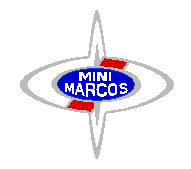
History of the Mini Marcos Family3. The Mini Marcos
3.1 GeneralFollowing the cancellation of Dizzy Addicott’s DART project, Jem Marsh set about making a replacement. The car was designed by Brian Moulton (see Brian’s notes) with Malcolm Newell as pattern maker, along the same lines as the Mini Jem but modified to give it a family resemblance to the larger Marcos cars. The Mini Marcos was somewhat simpler in construction and rather untidy at the front with a large flat radiator box angled downwards under the nose. A Mini side radiator could be fitted but most builders preferred the front radiator option. The new baby made its debut at Castle Combe circuit in September 1965 (see report). The track was wet which suited front wheel drive and in the hands of local Mini exponent Geoff Mabbs, the Mini Marcos thrashed the opposition, lapping all but one, a Ginetta, to win by over a minute. The car was exhibited at the Racing Car Show at Olympia, London, in January 1966, a full year ahead of the Mini Jem. Le MansA “Marcos BMC” driven by Claude Ballot-Léna and Jean-Louis Marnat was entered in the 1966 Le Mans 24-hour race. Apparently Marnat, a French garage owner and Austin dealer obtained two Mini Cooper ‘S’ engines to Group 2 specification from the BMC Competition Department on condition that they would be unattributable. Competing against the might of Porsche, Ford and Ferrari, the diminutive car finished in 15th place and was the only British car to qualify as a finisher. In fact it only just made the qualifying distance despite Jem Marsh’s entreaties to the team to go slower! The car was stolen in 1975 and was not been heard of until it turned up as a bare shell in Portugal in 2016. Billy Dulles describes the events leading up to the 1966 race in Sport Scene. Jem Marsh returned to the Sarthe circuit the following year with a more streamlined car and was clocked at 146 mph on the Mulsanne straight. Unfortunately an oil pump failure forced the car to retire early in the race. This car subsequently raced at Spa and took part in the 9-hour race at Kyalami, after which it was sold and is now in Zimbabwe. Land Speed RecordsRacing was not the Mini Marcos’s only forté. Steve Roberts in the Trans-XL Mini Marcos set four British land speed class records which survive to this day. These are the flying mile, half mile, kilometre and 500m for cars up to 1600cc. Many of the cars are still regularly campaigned in historic sportscar races, sprints and hillclimbs around the world. The Mark II/IIIIn 1967 the body shape was revised, with a larger front number plate panel, recessed fuel filler and simpler, semi-circular wheel arches instead of the distinctive notched design. This was known as the Mk.II and was the prototype for the famous Corgi Mini Marcos GT models. The original cars became known as Mk. I. Mk.II and Mk.III cars are similar. It appears that new moulds were made at some point as there are detail differences around the door and bonnet openings. An opening rear hatch was offered on later cars but it isn’t clear whether the newer moulds incorporated the hatch surround or whether it was put in afterwards. As we have no records of which cars are which, as far as this site and the club are concerned all these cars are known as Mk.III. The Mk. III was the most numerous version and the only Mini Marcos to be homologated. A batch of 50 cars was “built” between February 1967 and January 1968). Rumour has it that the same batch of 25 cars was inspected twice, with different chassis numbers, but let’s gloss over that one. As a road car it had the disadvantage of a fixed rear window which made access to the luggage space difficult. This was overcome when the opening rear hatch was introduced. buy carisoprodol online uk www.team-medic.com/medical-services/event-first-aid/
In addition to cars produced by Marcos in Bradford-on-Avon, a batch of 40 was made under licence in Ireland, and a similar number by Brian Raubenheimer in Pietermaritzburg, South Africa. Trouble At MillThe unsuccessful launch of the four-seater Mantis, and an unsuccessful venture into the American market (not least because a consignment of cars had been impounded by US Customs) led to the collapse of Marcos Cars Components Limited in 1971. The company was bought by Rob Walker’s Corsley Garages (owned by the famous formula 1 privateer and heir to the Johnnie Walker whisky business) and traded as Marcos Limited. The Mk. IV Mini Marcos was introduced by this company. The body was substantially updated, with a new floor pan based on the Mini Traveller and a rear hatch as standard. It was longer and taller than its predecessors, giving more interior space and a better driving position.
Greeenfield SiteIn 1975 production of the Mini Marcos was taken over by D & H Fibreglass Techniques Ltd. in Oldham, Lancashire. The company was established by ex-Jaguar engineer Harold Dermott and Maurice Holt in the same year. With minor changes the model continued in production until 1981 when Dermott brought out the Richard Oakes designed Midas. The company later expanded and moved to a new factory at Corby where it traded as Midas Cars Ltd. However the aftermath of a serious fire at Corby led to the demise of Midas, and under the terms of the original agreement the Mini Marcos moulds and rights reverted to Jem Marsh, who by this time had regained the Marcos company. Meanwhile Midas was purchased by Pastiche Cars of Rotherham, who themselves soon went bust and were taken over by GTM. This firm kept and developed the A+ Metro-based Midas Gold convertible, and sold the Mini-based Bronze to Midtec. Return to the FoldThe depression in the late eighties caused a fall in demand for the more expensive Rover V8-engined Mantula, and Marcos looked to cheaper alternatives to fill the order book. The coup顢ody was adapted to use Ford Cortina Mk.IV parts and launched as the Martina, while in 1991, the Mini Marcos’s Silver Jubilee year, and in response to considerable interest from Japan, the Mini Marcos was further updated and given a new lease of life. The Mk.V had larger arches to accommodate 12" wheels (or 13" with low profile tyres) and a front air dam. Wind-up windows and the later push-button door locks were fitted, along with the rubber mounted front subframe, but the traditional Mk.1/2 Mini external door hinges were retained. A rear spoiler was available but few if any of these were sold. Although only sold in the UK as a kit car, a number of fully built vehicles was made for export. For this purpose Marcos would purchase a complete Mini 1.3i, strip out the mechanical components and sell the steel shells. This proved to be cheaper and less hassle that attempting to obtain the necessary parts separately from Rover. An air conditioning unit was available, and was fitted under the dashboard on the passenger’s side. In all ten cars were sold to Japan and several others went abroad. Production of the Mk.V Mini Marcos continued until 1995. Although the company has ceased production of all component cars to concentrate on its successful and more lucrative Mantara, LM500/600 and Mantis models. Two shells were produced for a French racing outfit, with the intention of more to follow. However this proved a false hope as apparently no finance was forthcoming. Marcos Heritage Mk. VIAfter Marcos Sales Limited in Westbury went into voluntary liquidation the Mini Marcos moulds were acquired by Rory McMath of Marcos Heritage Spares. They are able to supply spare panels for the Mini Marcos and even complete shells. Following in the wake of Mini Marcos successes at events such as the Goodwood Revival Meeting and the Fastest Mini in the World races at Silverstone, Marcos Heritage relaunched the Mini Marcos in 2005 as the Mk. VI and Mk. VI GT. The standard car is basically the same as the Mk. V, whilst the GT version has a detachable racing front end and one piece perspex door windows (so more for racing than grand touring). The Mini Marcos is the little car with the big heart that just refuses to die! Richard Porter
|
Last updated 9th November, 2021


 Home
Home